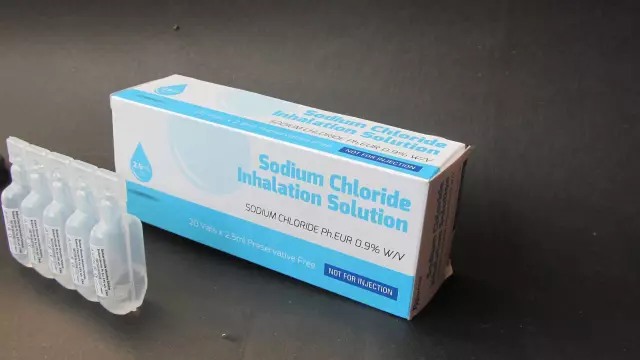- Author Rachel Wainwright [email protected].
- Public 2023-12-15 07:39.
- Last modified 2025-11-02 20:14.
Sodium thiopental
Thiopental sodium: instructions for use and reviews
- 1. Release form and composition
- 2. Pharmacological properties
- 3. Indications for use
- 4. Contraindications
- 5. Method of application and dosage
- 6. Side effects
- 7. Overdose
- 8. Special instructions
- 9. Application during pregnancy and lactation
- 10. Use in childhood
- 11. In case of impaired renal function
- 12. For violations of liver function
- 13. Use in the elderly
- 14. Drug interactions
- 15. Analogs
- 16. Terms and conditions of storage
- 17. Terms of dispensing from pharmacies
- 18. Reviews
- 19. The price of sodium in pharmacies
Latin name: Thiopental Sodium
ATX code: N01AF03
Active ingredient: thiopental sodium (thiopental sodium)
Manufacturer: JSC SINTEZ (Russia)
Description and photo update: 2018-26-10

Thiopental sodium is an anesthetic non-inhalation agent.
Release form and composition
Dosage form of Thiopental sodium - powder for preparation of a solution for intravenous administration: hygroscopic, color - white or almost white, or from yellowish-white to pale greenish-yellow (0.5 g each in 10 or 20 ml vials, 1 g each vials with a volume of 20 ml, in a cardboard box 1, 5 or 10 bottles; packaging for hospitals - 50 bottles in a cardboard box).
Active ingredient: sodium thiopental, in one bottle - 0.5 or 1 g.
Pharmacological properties
Pharmacodynamics
Thiopental sodium - a derivative of thiobarbituric acid, non-inhalation agent for general anesthesia, ultra-short acting. It has a pronounced hypnotic, weak analgesic and some muscle relaxant effect.
It slows down the opening time of channels dependent on GABA (gamma-aminobutyric acid) on the postsynaptic membrane of neurons in the brain, causes hyperpolarization of the membrane, and lengthens the time of entry of chloride ions into the nerve cell. Suppresses the excitatory effect of amino acids (glutamate and aspartate).
In high doses, it directly activates GABA receptors, due to which it has a GABA-stimulating effect.
Increases the threshold of neuronal excitability, blocks the conduction and propagation of convulsive impulses in the brain, as a result of which it also has anticonvulsant properties.
Suppresses polysynaptic reflexes and slows down the conduction of the interneurons of the spinal cord, which contributes to muscle relaxation.
Reduces the utilization of oxygen and glucose by the brain, as well as the intensity of metabolic processes in the brain.
The hypnotic effect of Thiopental sodium manifests itself in accelerating the process of falling asleep and changing the structure of sleep.
The drug has a dose-dependent ability to inhibit the respiratory center and reduce its sensitivity to carbon dioxide. It also has a dose-dependent cardiodepressant effect, namely, it reduces the minute and stroke volume of blood, and lowers blood pressure. Increases the capacity of the venous system, reduces the glomerular filtration rate and hepatic blood flow.
The drug has an exciting effect on the vagus nerve (nervus vagus), can cause profuse mucus secretion and laryngospasm.
General anesthesia occurs within 30-40 seconds after intravenous administration of Thiopental sodium, after 8-10 minutes - after rectal administration. After a single dose, the duration of anesthesia is 10-30 minutes, ending with some drowsiness and retrograde amnesia. The analgesic effect of the drug ends when the patient wakes up.
Pharmacokinetics
After intravenous administration, thiopental sodium rapidly penetrates into the brain, liver, kidneys, adipose tissue and skeletal muscles. The maximum concentration in the brain reaches within 30 seconds, in the muscles - within 15-30 minutes. In fat depots, the concentration is 6-12 times higher than in blood plasma.
The drug is characterized by a relatively high binding to plasma proteins - 76-86%. The volume of distribution is 1.7-2.5 l / kg, in pregnant women - 4.1 l / kg, in obese patients - 7.9 l / kg.
Thiopental sodium crosses the placental barrier. Excreted in breast milk.
The metabolic process occurs mainly in the liver, as a result of which inactive metabolites are formed. An insignificant part of the drug is inactivated in the kidneys and the brain, about 3-5% of the administered dose is desulfurized to pentobarbital.
The half-life in adults is: in the distribution phase - 5-9 minutes, in the elimination phase - 3-8 hours. Time can increase to 10-12 hours, in pregnant women - up to 26.1 hours, in patients with concomitant obesity - up to 27.5 hours. The half-life in children is 6.1 hours.
The clearance of the drug is 1.6-4.3 ml / kg / minute, during pregnancy - 286 ml / minute.
Sodium thiopental is excreted mainly by the kidneys by glomerular filtration.
In the case of repeated use of the drug, cumulation is noted, which is associated with its ability to accumulate in adipose tissue.
Indications for use
Thiopental sodium is used as a general anesthetic for short-term surgical interventions, as well as for induction and basic general anesthesia (followed by the use of muscle relaxants and analgesics).
In addition, the drug can be used in the following cases:
- status epilepticus;
- large epileptic seizures (grand mal);
- increased intracranial pressure;
- drug synthesis and drug analysis in psychiatry;
- prevention of cerebral hypoxia (with carotid endarterectomy, artificial circulation, neurosurgical operations on the vessels of the brain).
Contraindications
- diseases that are a contraindication for general anesthesia;
- asthmatic status;
- shock;
- malignant hypertension;
- porphyria, including acute intermittent (including in the history of the patient or his immediate family);
- intoxication with drugs for general anesthesia, sleeping pills, narcotic analgesics or ethanol;
- lactation period;
- hypersensitivity to the drug.
Thiopental sodium should be used with caution in the following cases: childhood, obesity, pregnancy, inflammatory diseases of the nasopharynx, febrile syndrome, chronic obstructive pulmonary disease, bronchial asthma, muscular dystrophy, myotonia, cachexia, myasthenia gravis, myxedema, Addison's disease, hypovolemia, anemia, diabetes mellitus, arterial hypotension, severe cardiovascular insufficiency, severe violations of myocardial contractile function, collapse, hepatic and / or renal failure, excessive premedication.
Instructions for the use of thiopental sodium: method and dosage
Thiopental sodium is administered slowly (to avoid collapse) intravenously.
Adults are shown the use of a 2-2.5% solution, less often - 5% (in this case, the fractional administration technique is used), weakened elderly patients and children are injected with a 1% solution.
The solution is prepared in sterile injectable water immediately before administration. Pre-medication is carried out with metacin or atropine.
For the introduction of adults into general anesthesia, a trial dose of 25-75 mg is first administered. After 60 seconds, the main dose is administered - 200-400 mg (50-100 mg at intervals of 30-40 seconds until the desired effect is achieved or once at the rate of 3-5 mg / kg of body weight). The recommended dose for maintaining anesthesia is 50-100 mg.
Dosing regimens for adults for other indications:
- convulsions (to stop them): 75-125 mg intravenously for 10 minutes;
- convulsions with local anesthesia (to stop them): 125-250 mg for 10 minutes;
- cerebral hypoxia: 1.5-3.5 mg / kg for 1 minute until the temporary arrest of blood circulation;
- drug analysis: 100 mg for 1 minute. The patient is offered to slowly count from 100 to 1. Immediately before falling asleep, the administration of the drug is stopped, since the patient must be in a semi-awake state to maintain the ability to answer questions.
The maximum single dose of Thiopental sodium for adults is 1000 mg (50 ml of a 2% solution).
Patients with impaired renal function (creatinine clearance <10 ml / min) are administered 75% of the average dose for an adult patient.
The recommended injection rate of the solution is no more than 1 ml per minute. In the beginning, 1-2 ml is usually injected, after 20-30 seconds - the rest.
For children, the drug is administered intravenously in a stream for 3-5 minutes, once at a dose of 3-5 mg / kg.
Recommended doses before inhalation anesthesia without prior premedication: newborns - 3-4 mg / kg, children from 1 to 12 months - 5-8 mg / kg, children from 1 to 12 years old - 5-6 mg / kg.
The dose for children weighing 30-50 kg with general anesthesia is 4-5 mg / kg. The maintenance dose is 25 to 50 mg.
Children with impaired renal function (creatinine clearance <10 ml / min) are administered 75% of the average pediatric dose.
Side effects
- on the part of the cardiovascular system: arrhythmia, decreased blood pressure, tachycardia, collapse;
- from the nervous system: lethargy, dizziness, headache, ataxia, muscle twitching, increased vagus nerve tone, epileptic seizures, drowsiness in the postoperative period, anterograde amnesia, anxiety; in rare cases - radial nerve palsy, postoperative delirious psychosis (agitation, confusion, anxiety, hallucinations, anxiety, back pain, restless legs syndrome);
- on the part of the respiratory system: hypersecretion of bronchial mucus, sneezing, cough, dyspnea, apnea, bronchospasm, laryngospasm, depression of the respiratory center, hypoventilation of the lungs;
- from the digestive system: abdominal pain, nausea, vomiting and hypersalivation in the postoperative period;
- allergic reactions: rhinitis, rash, urticaria, pruritus, skin flushing, anaphylactic shock; in rare cases - hemolytic anemia with impaired renal function (loss of appetite, nausea, vomiting, unusual weakness, pallor of the skin, fever, pain in the stomach, legs and lower back);
- local reactions: soreness at the injection site, tissue irritation at the injection site (peeling and flushing of the skin), vascular spasm and thrombosis at the injection site, thrombophlebitis (with the introduction of solutions with a high concentration of sodium thiopental), damage to the nerves suitable for the injection site, necrosis;
- others: hiccups.
Overdose
An overdose of the drug can manifest itself with the following symptoms (with the toxic effect starting from the first seconds): a pronounced decrease in blood pressure, tachycardia, water-electrolyte disturbances, laryngospasm, respiratory depression (up to apnea), muscle hyperreactivity, convulsions, depression of the central nervous system (CNS), post-anesthetic delirium. When a very high dose is administered, circulatory collapse, pulmonary edema, and cardiac arrest are possible.
The antidote to sodium thiopental is bemegrid. Appointments for concomitant disorders: laryngospasm - 100% oxygen under pressure and muscle relaxants; respiratory arrest - 100% oxygen and artificial lung ventilation; a pronounced decrease in blood pressure or collapse - plasma-substituting solutions, vasopressive drugs and / or drugs with a positive inotropic effect; convulsions - diazepam. If therapy is ineffective, muscle relaxants are prescribed and artificial lung ventilation is performed.
special instructions
Thiopental sodium belongs to the list of potent substances No. 1 of the Standing Committee for Drug Control of the Ministry of Health of the Russian Federation.
Thiopental sodium is used by anesthesiologists-resuscitators only in specialized medical institutions equipped with the equipment and means necessary to maintain cardiac activity and ensure airway patency, including artificial ventilation.
The time to achieve and maintain general anesthesia of the required depth and duration depends not only on the amount of the drug, but also on the patient's individual sensitivity to sodium thiopental.
The solution is administered intravenously only. In case of accidental intra-arterial injection, an instantaneous spasm of the vessel occurs, accompanied by impaired blood circulation further from the injection site, which can lead to thrombosis of the main vessel, the subsequent development of necrosis and gangrene. The first sign of intra-arterial administration of the drug in patients who are conscious is a complaint of a burning sensation along the artery, in patients under anesthesia - dark skin color, spotted cyanosis or transient blanching. In this case, the cessation of the administration of Thiopental sodium, the introduction of a solution of heparin into the lesion site with further anticoagulant therapy, the administration of a glucocorticosteroid solution followed by systemic therapy, a blockade of the brachial plexus or sympathetic blockade (intra-arterial administration of procaine) is indicated.
If the drug accidentally gets under the skin, chemical irritation of tissues is possible, which is associated with a high pH value of the solution. For a quick resorption of the infiltrate, it is recommended to administer a local anesthetic and warm it up to activate the local circulation.
Patients with inflammatory diseases of the upper respiratory tract need to ensure their patency, up to tracheal intubation.
With intravenous jet injection of Thiopental sodium, children or adolescents under 18 years of age should be carefully monitored in order to identify in time the symptoms of a possible decrease in blood pressure, hemolysis, respiratory depression, extravasation.
Subcutaneous swelling is a sign of extravasation.
Patients receiving digoxin or diuretics, and patients who received morphine during premedication, as well as after the administration of diazepam or atropine, the dose of Thiopental sodium should be reduced.
Premedication can be carried out with any of the conventional drugs, with the exception of phenothiazine derivatives.
With prolonged anesthesia, when the hypnotic effect of sodium thiopental is supported by the use of inhalation anesthetics and / or intravenous administration of long-acting anesthetics, the dose of sodium thiopental should not exceed 1000 mg, which is associated with the risk of a cumulative effect.
In alcohol abuse patients, the anesthetic effect of the drug is unreliable.
Subject to the implementation of artificial ventilation, sodium thiopental can be used in combination with muscle relaxants.
The drug increases the tone of the nervus vagus, therefore, an adequate dose of atropine is indicated before its use. Immediately after the onset of general anesthesia, an airway must be maintained. The development of addiction is possible.
Application during pregnancy and lactation
Thiopental does not affect the tone of the uterus during pregnancy. After administration, the maximum concentration in the umbilical cord reaches within 2-3 minutes. The maximum permitted dose is 250 mg. The drug can depress the central nervous system in newborns.
During pregnancy, Thiopental sodium is used only in special cases, when the expected benefit outweighs the potential risks.
During lactation, the use of anesthetic is contraindicated.
Pediatric use
In childhood, the drug is used with caution and only in the form of a 1% solution.
With impaired renal function
Patients with impaired renal function (creatinine clearance less than 10 ml / min) are prescribed 75% of the usual dose.
For violations of liver function
According to the instructions, Thiopental sodium should be used with caution in liver failure.
Use in the elderly
Weakened elderly patients are injected with a 1% solution of the drug.
Drug interactions
Thiopental sodium reduces the effect of contraceptives, indirect anticoagulants (coumarin derivatives), glucocorticosteroids, griseofulvin. Strengthens the effect of drugs that promote the development of hypothermia, the toxic effects of methotrexate.
Pharmaceutically incompatible with narcotic analgesics (codeine, morphine), muscle relaxants (suxamethonium, tubocurarine), anxiolytic drugs (tranquilizers), antibiotics (amikacin, benzylpenicillin, cefapirin), ascoru- rinic acid, epitopolymerine, chloramphenolamines ephedrine, atropine. Do not mix sodium thiopental in the same syringe or inject through the same needle with acidic solutions.
The action of sodium thiopental is weakened by some antidepressants, analeptics and aminophylline, and increased by H 1 -histamine blockers and drugs that block tubular secretion (for example, probenecid).
With the simultaneous use of diazoxide, the risk of lowering blood pressure increases.
Ketamine lengthens the recovery time after recovery from general anesthesia, increasing the risk of respiratory depression and lower blood pressure.
When thiopental sodium is combined with antihypertensive drugs, diuretics or ganglion blockers, the hypotensive effect is enhanced.
Magnesium sulfate enhances the inhibitory effect on the central nervous system.
With the combined use of ethanol or drugs that depress the central nervous system, pharmacological actions are mutually reinforced. Possible significant depression of the central nervous system and respiratory function, increased hypotensive effect and degree of anesthesia.
Sodium thiopental antagonizes bemegrid.
Analogs
Thiopental is an analogue of sodium thiopental.
Terms and conditions of storage
Shelf life is 2 years.
Store at a temperature not exceeding 25 ° C, out of the reach of children, dry and protected from light.
Terms of dispensing from pharmacies
Dispensed by prescription.
Reviews about thiopental sodium
If the drug is administered correctly and in an adequate dose, complications after surgery with its use should not arise. Rare negative reviews about Thiopental sodium concern the development of side effects. At the same time, experts, as a rule, do not associate their occurrence with the use of this anesthetic and refer to other reasons.
Price for Thiopental sodium in pharmacies
The price of Thiopental sodium is unknown, since the drug is used only in a hospital setting, and it is difficult to find it on the market.

Maria Kulkes Medical journalist About the author
Education: First Moscow State Medical University named after I. M. Sechenov, specialty "General Medicine".
Information about the drug is generalized, provided for informational purposes only and does not replace the official instructions. Self-medication is hazardous to health!






